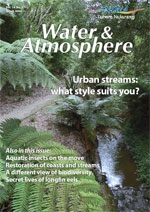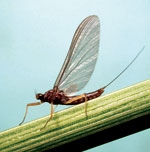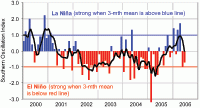PDF of this article (257 KB)





Brian Smith and Kevin Collier have used a trapping study to discover how insects cross ridges to move between unconnected habitats.
Many aquatic insects have a winged adult stage. Little is known about the behaviour and ecology of these adults, probably because stream ecologists usually work with the immature or larval stages. NIWA has been researching the terrestrial phase of aquatic insects, trying to shed some light on what happens to them once they leave the water.
Getting out and about in the colonisation cycle
Some adult aquatic insects, such as dragonflies and some caddisflies, are highly mobile and potentially able to cover great distances, while others, such as mayflies and midges, are more likely to swarm above their birth stream. Individuals that disperse widely can play important ecological roles, not only by exchanging genetic material with neighbouring populations, but also by colonising sites following habitat restoration or large-scale disturbances such as landslips, flooding, or volcanism.
The concept of the 'colonisation cycle' is widely known to stream ecologists. This predicts that the upstream flight of adult aquatic insects is necessary to compensate for the number of juveniles that move downstream during the course of their life, or, in other words, 'adult replacement for larval displacement'. This is all very well for stream systems confined within a single catchment, but what about inter-catchment dispersal? Dispersal between unconnected aquatic systems, such as those in neighbouring catchments, requires the overland movement of winged adults. This highlights another important ecological concept: habitat 'connectivity'.
Pinning down insect movements
Previously, our research has shown that not all adult caddisflies move upstream when they emerge. Some were recorded flying at least 200 m into the forest (the maximum distance we measured). One overseas study has shown that some caddisflies are capable of flying an amazing 16 km from their emergence point!
Recently we began investigating whether adult aquatic insects (mayflies, caddisflies, and stoneflies) are capable of dispersing across ridge-tops into neighbouring catchments. In a preliminary study at the Whatawhata Research Station near Hamilton, we chose three sites with varying proximity to native forest and to pasture streams that were a potential source of new recruits (see figures of sites 1–3).
- Site 1 was a ridge-top surrounded by pasture, with no native forest nearby, and the nearest streams about 210 and 280 m either side of the ridge.
- Site 2 was also a pasture ridge-top, but with unconnected native forest fragments nearby and the nearest streams about 180 and 320 m either side of the ridge.
- Site 3 was a pasture-native forest boundary ridge-top with one of the nearest streams approximately 120 m through dense native forest, and the other a pasture stream about 220 m from the ridge-top.
We used a combination of trapping methods involving passive traps (double-sided Malaise net) and attractant traps (ultraviolet light). These insect traps were set from November to April, when adult aquatic insects were most active. We also recorded microclimate factors that could potentially influence dispersal direction and distance, including wind velocity, wind direction, and air temperature.
The usual suspects
In total, we caught 36 species of caddisflies, mayflies, and stoneflies in the ridge-top Malaise and light traps. Caddisflies (32 species) dominated samples in number of individuals and species; only three stoneflies and a single mayfly were recorded from the ridge-tops. The family composition of the caddisflies is shown in the graphs above.
The prevailing wind direction at our sites was west-southwest, with an average speed of 11 km/h but gusting up to 47 km/h. We assume that adult aquatic insects caught in one side of the Malaise net were moving in that direction – either actively or passively – at the moment of capture; this is called 'instantaneous flight direction'. As mayflies, stoneflies, and caddisflies were caught in our traps, albeit in varying numbers, instantaneous flight direction suggests that both strong fliers (caddisflies) and weaker fliers (mayflies, stoneflies, and some caddisflies) may be able to cross ridges into other catchments. However, instantaneous flight direction appeared unrelated to prevailing wind direction measured continuously over the course of our study.
Wide open spaces vs forested corridors
Open landscapes such as pastures, or habitats lacking forested connectivity with streams, are thought to limit the dispersal of some species into neighbouring catchments. In our study, adult aquatic insects known to be associated with forested streams were caught only at the boundary of the native forest-pasture ridge-top (Site 3). This result suggests that some of those species of adults had flown through dense native forest to reach the ridge-top, but did not appear to be flying across open landscapes, as these species were not caught at Sites 1 and 2.
Forest connectivity not only offers a potential corridor for dispersal for adult aquatic insects, but also food, and shelter from extreme temperatures and drying winds, particularly if the adults are long-lived such as stoneflies and some caddisflies. During our sampling period, air temperature at the pasture ridge-top (Site 1) ranged from 2 to 28 °C (with a mean temperature of 16 °C). Recent NIWA research has indicated that adult temperature tolerance may limit dispersal capabilities, as temperatures greater than 24 °C can cause rapid mortality in some adult aquatic insects and air temperatures around 30°C will cause at least a 50% mortality in the species tested. In non-forested landscapes, mid-afternoon summer temperatures can, in some instances, exceed 35 °C.
Catching a fair wind
Although forest cover may assist dispersal of some forest-dwelling adults, conversely, open sites and associated microclimate conditions, such as exposure to increased wind, may also assist the dispersal of short-lived or weak-flying species. Weak-flying adults are potentially at the mercy of the wind; however, this is not necessarily as bad as it sounds, and may in fact be an adaptive trait geared towards increasing their dispersal capability.
Mayflies have large, sail-like forewings with many folds and creases that create a large surface area ideal for catching the wind. In fact, mayfly wings appear very similar to the sails of a yacht. Mayflies are renowned for forming mating swarms many metres above streams or inanimate objects such as bridges and large boulders. This upwards-swarming behaviour of mayflies, combined with their wing design, may be an adaptive feature enabling them to catch the wind and increase dispersal distance.
In an earlier Water & Atmosphere article, the question was posed: 'How far may a mayfly fly?' Well, we're still working on that, but maybe we should be asking the question 'How far may a mayfly sail?' It could be much farther than we think!
Fly away
- Some adult aquatic insects maintain populations by flying to new territory.
- This trapping study investigated their ability to cross ridges to reach unconnected habitat.
- While some species actively fly, others have evolved sail-like wings that may help catch the breeze.
Further reading
'How to catch invertebrates' in Collier, K. (2001). Measuring stream invertebrate biodiversity. Water & Atmosphere 9(3): 14-15.
Collier, K.; Parkyn, S.; Quinn, J.; Scarsbrook, M. (2002). Bouncing back: how fast can stream invertebrates recolonise? Water & Atmosphere 10(2): 9-11.
Collier, K.; Smith, B. (1998). The secret lives of adult aquatic insects. Water & Atmosphere 6(4): 24-26.
Brian Smith is a freshwater ecologist working at NIWA in Hamilton, specialising in the taxonomy and ecology of aquatic insects. You can read more about Brian in the profile in this issue. Dr Kevin Collier is a freshwater ecologist with Environment Waikato.
Teachers’ resource for NCEA AS: Biology 90164 (1.4), 90460 (2.4), 90461 (2.5), 90716 (3.4). See other curriculum connections at www.niwa.co.nz/pubs/wa/resources
